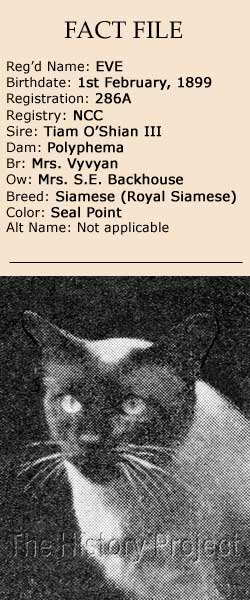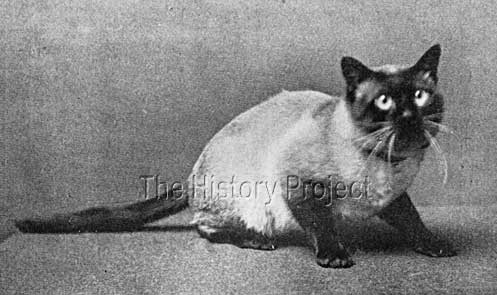 | |||||||||||









|
EVE (1899)PHOTOS | SOCIAL MEDIA | REFERENCES
HISTORICAL BACKGROUND:In the early history of Siamese, there is a tendency to view the contribution made by the stud males, almost to the exclusion of that made by the females of the variety. But there were a small number of very good quality females, who were both successful on the show bench, as well as being brilliant brood queens. These are the ones who left behind them, litters containing kittens that would in their turn, make a significant contribution to the overall establishment of the breed. Two queens fulfilling these criteria were 'Champion Eve' and her dam, 'Polyphema'. The risks associated with showing were not to be underestimated. 'Show fever', as distemper was invariably called, was a very real threat, and many an excellent specimen was shown, only to return home to die. The subsequent losses, and the cost to the fledgling breeds, were inestimable! And this was the sad reality of showing breeding stock. At some shows, classes were cancelled due to the lack of entries, mostly caused through the fear of entering after experiencing or witnessing instances or a period of loss. In these times, before the development of vaccines or microbe specific disinfectants, only the cats with the very best of constitutions could be shown multiple times and the risk of exhibiting kittens, with barely developed immunity, was considerable. An early example of the cost in Siamese, were the progeny of 'Pho' and 'Ma', direct imports from the Palace in Bangkok, belonging to Mrs. Lilian Gould. 'Duen N'gai' was born to this pair in March 1885, and 'Kalahom' and 'Kromata', in July 1885. All three were shown at the Crystal Palace Show of that year and afterwards, all died. Another was 'Koschka', from 'Ch. Wankee' and 'Klinkie' born 16th May 1899, a superlative specimen who was shown at Westminster in 1900 and who died shortly afterwards. Mrs. Parker Brough explains the breeder's fear of showing kittens: "Owners run a great risk in sending their Siamese (especially kittens) to shows, as in addition to being more liable to take cold, are apt to fret themselves ill at being separated from their mistresses. Many fanciers are leaving off showing Siamese for that reason."1 When one considers the tragedy of these losses, it is easy to see how the breed gained a reputation for being "delicate", and "more sensitive" than even the most delicate of longhaired breeds. Miss Armitage of 'Chaseley' cattery comments:
"I find the way to succeed in breeding and rearing Siamese kittens is to only keep a few. I strongly believe in putting them forth into cottage homes. Distemper breeds like wildfire amongst this breed, and it is heartrending to lose whole litters at once. It is strange how much stronger the females are than the males. I have never lost a female kitten yet; but alas! many a promising male."1 Yet despite these disappointments, the dedication of these early breeders won through, and it is thanks to their sheer determination and hard work, that we can count the Siamese today among the most popular breeds on the planet. PARENTAGE & OWNERSHIP:'Eve' was born in February 1899, bred by Lady Vyvyan, from 'Tiam O'Shian III' and the beautiful 'Polyphema'. This breeding was a direct double-up (Father to daughter breeding), based on 'Tiam O'Shian III', as he was already the sire of 'Polyphema'.
Puppy, seal point
Tiam O'Shian III, seal point
| Susa, seal point
Eve, Feb-1-1899, Seal Point Siamese, F
| Tiam O'Shian III, seal point
Polyphema, seal point
Priscilla, seal point
Miss Forestier Walker, sister to Lady Vyvyan, recounts in The Book of The Cat (1903), the origins or their strain of Siamese: "A pair from the Palace were given to Mrs. Vyvyan and myself in 1884-5,and we have been very careful in breeding, mating when possible with such good cats as Mrs. Lee's celebrated 'Meo', Miss Moore's 'Siam', Mrs. Harrington's 'Mechi', etc, and have bred in consequence, the famous 'Tiam-O-Shians' II, III and IV., 'Polyphema', 'Susa', 'Kitya Kara', 'Goblin', 'Champion Eve', 'Mafeking', 'Vishuddha', 'Ah Choo', 'Suzanne' and many others."1 'Eve' became the property of Mrs. Backhouse, who was mentored by Mrs. Forestier Walker and Mrs. Vyvyan. She became an ardent supporter of the Siamese, and when the Siamese Cat Club was officially formed in January 1901, she was elected as its Honorary Treasurer.2 Not long after the formation of the Club, a decision was taken to write to Fur and Feather, to draw attention to what the Club members saw as the "unfortunate diversity of opinion concerning Siamese cats expressed in articles which appear from time to time". The letter then explained that one great object of the Club was to encourage the breeding of the 'Royal Cat of Siam', and also the 'Chocolate Cat of Siam', "both beautiful in their own way, but recognised as distinct breeds." It should be remembered that at this time, the 'Royal Cat of Siam', was a fully pointed blue eyed cat, and the Chocolate, was a lighter mid-brown cat, with only slightly darker points and yellow eyes. Mrs. Backhouse, was one of the notable signatories to the letter. SIBLINGS & SHOWS:'Eve' is in excellent and famous company with her full siblings, but she can claim the distinction of being the oldest, being born from 'Polyphema's' litter of February 1899. She was also the first of 'Polyphema's progeny to gain her Championship.
In a subsequent litter from 'Polyphema' born 15th May 1899, were two males; one of them being the famous 'Tiam O'Shian IV', who very quickly became the most popular Siamese male in the country beside 'Ch. Wankee.' The second male from this litter was 'Vishuddha'. 'Tiam O'Shian' was retained at stud by Lady Vvvyan, while 'Vishuddha' was held by her sister, Mrs. Forestier Walker. 'Vishuddha' was shown, gaining a First and Challenge, at the Botanic Gardens Show of 1900.5 'Tiam O'Shian', of course, was widely used, but sad to say, despite this few, if any, of his own lines have survived to this day, but the combination that produced him, lives on in the progeny from his older sibling, 'Eve', who as the dam of 'Bandoola', is the forebear behind 'Prince Vudighi' and thence to 'Litabois', who may consequently be found behind most Siamese of today.
Then on 3rd May, 1900, the breeding was again repeated and this time 'Polyphema' produced two females, which included the lovely 'Ah Choo' and 'Suzanne'. 'Suzanne' was retained by Lady Vyvyan, but 'Ah Choo' went to Mrs. Robinson, the owner of 'Ch.Wankee'.5 'Ah Choo', who was a most appealing looking Siamese, had distinguished wins at Manchester in 1901, followed by Firsts at the Botanic and Crystal Palace Shows of 1902. Her photo, by Landor, is a delightful and revealing study, giving us an insight into what appears to be her friendly, almost 'impish', inquisitive personality. It also shows us the beautiful contrast between her light body colour and her dark, well defined points; a genetic trait, which has no doubt been passed down through the generations, through her sister 'Eve'. Unfortunately, there are no records of surviving progeny from either 'Ah Choo' or her litter sister, 'Suzanne'. Of Dam half-siblings, there is only the litter from 'Polyphema' and 'Ch.Wankee' born on 8th February, 1901, which included the three males 'Tamagno', 'De Reszke' and 'Van Dyke' (Van Dyck), as well as the female 'Nada'. However, none of these left any registered progeny.? Of Eve's own show career, we have the following comments from Miss Forestier Walker and Mrs. Parker Brough respectively:- "Mrs. Backhouse's 'Champion Eve' was a distinguished prize-winner, and Mrs. Robinson's 'Ah Choo' was chosen as a model for the medal of the Siamese Club".1 "Probably Mrs. Backhouse's 'Champion Eve' and Mrs. Vyvyan's 'Polyphema' were the best females exhibited."1 In the Siamese Register, compiled by Major E. Sydney Woodiwiss in 1924, 'Eve's wins included a First at the Crystal Palace in 1900, followed by Firsts at both the Botanic and Crystal Palace Shows of 1901. If she had gained the coveted Challenge at each of these shows, this would account for her having achieved the singular title of 'Champion'.5 BREEDING & PROGENY:Although a strikingly handsome and successful female on the show bench, it was as a brood queen that 'Eve' created her most lasting legacy. We can find five kittens in all from 'Eve', all sired by 'Ch. Wankee', but only two with a verifiable date of birth. These were 'Boojum', (a male), 'Bandoola, (a female), 'Sin Jin', (a female), and 'The Bogie Man' (a desexed male), the latter being born 7th April, 1900.5, and 'Ayah', (a female) born in August, 1901.
Regretfully, no images can currently be found of any of 'Eve's progeny. 'Prince Vudighi' , and hence, 'Boojum', 'Boojum II' 'Bandoola', 'Wankee' and 'Eve' may all be found on the pedigrees of many of today's Siamese, a great many coming down from the sons and grandsons of 'Prince Vudighi', through cats such as 'Litabois' and 'Bigabois' to name just a few. But without any doubt, it was only 'Eve', of ALL the progeny from 'Polyphema' and 'Tiam O'Shian III', that truly contributed to the furtherance of the Siamese breed and its establishment as a pillar of the Fancy. PHOTOS:
SOCIAL MEDIA :None currently available. In conclusion, let's leave the last word on the Siamese breed in this instance, to Frances Simpson: "These creatures are quite human in the way they look at you with those bonnie blue eyes, and when you talk to them they seem to answer in their croaking voice. I can well understand, what companionable cats these may become, and to fanciers of this unique breed other cats must appear lacking in interest and wanting in intelligence."1 We are confident that Mrs. Backhouse would agree. REFERENCES:
Registers associated with this article include The Incorporated Cat Fanciers Association of Great Britain (TICFAGB), National Cat Club (NCC), The Cat Club (CCR), Beresford Cat Club (BCC), Feline Federation Francaise (FFF), Siamese Cat Registry (SCR), US Register & Studbook for Cats (USR)including Supplement(USRS), The Studbook of the American Cat Association (ACA), and the Studbook & Register of the Cat Fanciers' Association (CFA).
|
||||||||||
Home | Cats | Gallery | Clubs | People | Artifacts | Articles | Updates | Contact Us ©The CFA Foundation, Inc and The Harrison Weir Collection
|
|||||||||||



